Check out our picks for the best TPU and other flexible filaments on the market to find the best flexible filament for your needs!
There are countless reasons why your 3D printed part may need to be flexible, bendy, elastic, or soft to the touch. Fortunately, there’s a growing range of filaments on the market that can deliver just the characteristics you’re looking for while being easy to print.
Flexible filaments can offer elasticity and durability, strength, and other attractive features, such as flame-retardancy, food-safety, and anti-bacterial properties. They can eliminate electrostatic discharge, resist fading in UV light, and stand up to chemical solvents, which makes them also ideal for industrial applications. More often today, you’ll find flexible filaments approved for long-term skin contact, so they’re ideal for prosthetics and wearable electronics. There are also flexible filaments made from 100% recycled material.
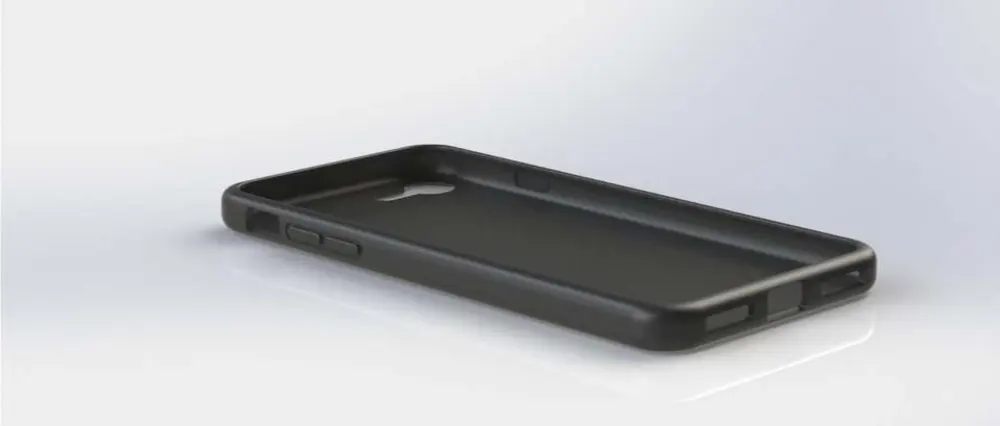
Here, we look at material options to consider for printing quality, flexible parts for everything from auto parts to smartphone covers. Flexible filament is made from a range of materials, including TPU, TPE, TPC, PEBA, and proprietary blends offering unique combinations of print characteristics.
There are far cheaper flexible filaments available than our picks here but, buyer beware. Unless your filament comes from a brand or reseller you trust and is accompanied by a full technical specification sheet, you’re risking hours of frustration with failed prints.
If you’re not quite sure what makes one flexible filament different from another or which Shore hardness you’re looking for, skip to the technical section at the end to learn more, and don’t miss our essential tips for printing with this sometimes tricky material.

| Company | Filament | Material | Shore | Elongation at break | Price (approx.) | Where to Buy |
|---|---|---|---|---|---|---|
| NinjaTek | NinjaFlex, Cheetah, Armadillo, Eel, Chinchilla | TPU, TPE | 85A, 75A, 75D, 90A, 75A | 660%, 580%, 295%, 355%, 600% | $45-90$ / .5 kg | |
| Fillamentum | Flexfill | TPU, TPE, PEBA | 92A & 98A, 90A & 96A, 90A | 600%, 250%, > 1000% | $40-$98 / .5kg | |
| Recreus Filaflex | Filaflex, Reciflex, Conductive | TPU | 60A, 70A, 82A, 95A, 98A, 92A | 950%, 900%, 650%, 500%, >400%, >100% | $39-$86 / .5kg | |
| Polymaker | PolyFlex TPU90, TPU95, TPU95-HF | TPU | 90A, 95A, 95A | 587%, 330%, 462% | $39-$67 / .75 kg | |
| Forward AM / BASF | Ultrafuse Flexible Filaments | TPU, TPC, TPS | 85A, 45D, 64D, 95A, 90A | 600%, 661% | $63-$80 / 1 kg | |
| ColorFabb | nGen Flex | – | 95A | 400% | $47 / .65 kg | |
| Kimya | PEBA-S, TPC-91A, TPC-ESD, TPU-92A, TPU-R | PEBA, TPC, TPU | 93A, 91A, 91A, 92A | >550% – 352% | $42-$92 / .75 kg | |
| Formfutura | FlexiFil, Python Flex, MD FLEX | TPC, TPU | 45D, 98A | 530%, 450% | $35-$73 / .5 kg | |
| MatterHackers | MatterHackers Pro Series | TPU, TPE | 90A, 98A | 508%, 600% | $45-$55 / .5kg | |
| 3D Jake | 3D Jake TPU A95 | TPU | 95A | 400% | $35 / .75 kg | |
| Dynamism TPU95 | TPU HS | TPU | 95A | – | $50 / 1 kg |
NinjaTek
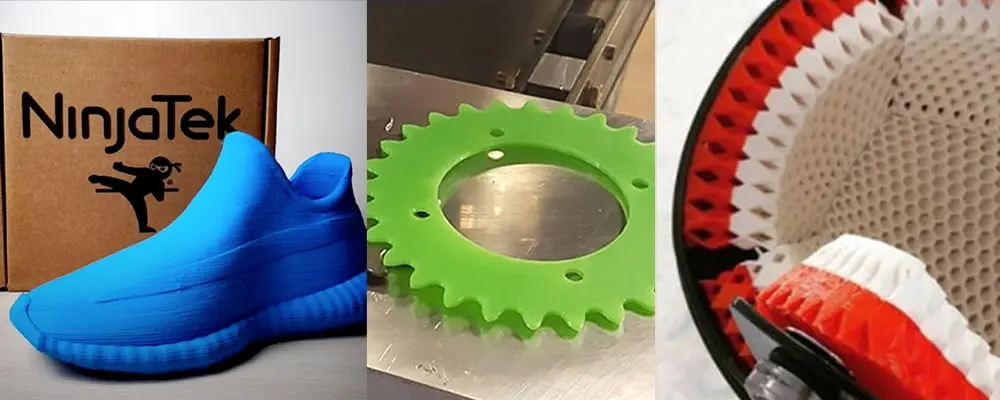
NinjaTek offers four kinds of TPU filament (NinjaFlex, Cheetah, Armadillo, and Eel) and one TPE, all with varying properties in a wide range of colors.
NinjaFlex has a shore hardness of 85A, making it extremely flexible and squishy. The company says its proprietary technology enables a low-tack, easy-to-feed texture ideal for direct-drive extruders. The material has abrasion and chemical resistance and results in consistent printed parts.
Cheetah TPU is designed to be able to print at higher speeds, hence the name, while the NinjaTek Armadillo is a non-flexible TPU that features the extremely tough and abrasion-resistant qualities of TPU in an extremely strong, rigid material that can be used as an alternative to PLA, ABS, and even nylon filaments. This TPU is meant for printing high-wear parts, such as gears, fasteners, and protective cases.
Lastly, the Chinchilla filament is the softest of the bunch, created through a proprietary blend of TPE resins. With Chinchilla, you can create soft, long-lasting printed parts for fashion, healthcare, and grips. Chinchilla has been tested to be skin-safe using EpiDerm Skin Model.
| Printing Temp. | Specific Gravity | Bed Temp. | Speed | |
| NinjaFlex | 225-250 °C | 1.19 g/cm3 | >50 °C | 15-35 mm/s |
| Cheetah | 225-250 °C | 1.22 g/cm3 | >50 °C | 50-80 mm/s |
| Armadillo | 210-230 °C | 1.18 g/cm3 | >40 °C | 35-60 mm/s |
| Eel | 220-230 °C | 1.18 g/cm3 | >45 °C | 45-60 mm/s |
| Chinchilla | 225-235 °C | 1.13 g/cm3 | >40 °C | 15-35 mm/s |
Available sizes & diameters: 0.5 kg, 1 kg: 1.75 mm, 3 mm
Colors: Midnight, snow, sapphire, fire, almond, and six others
Fillamentum
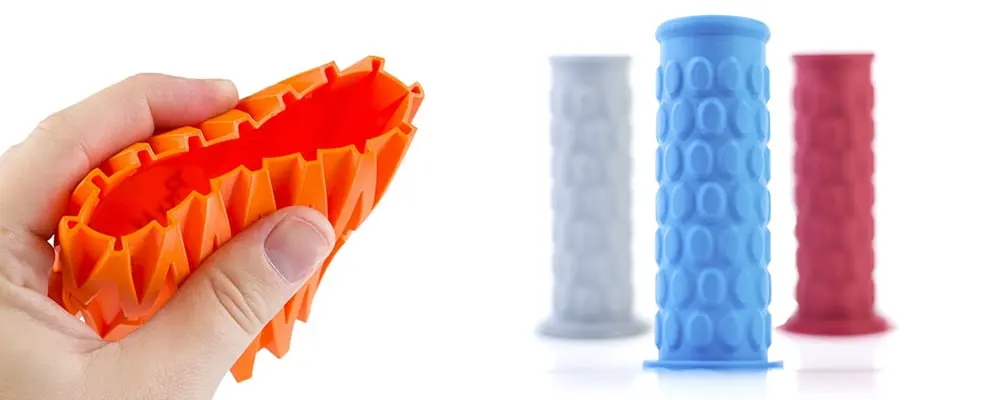
Fillamentum is a well-known, reliable filament manufacturer, and their Flexfill TPU is definitely worth a try. Flexfill TPU has two available shore hardnesses: 92A and 98A. The 92A line is very soft, while the 98A line is a bit stiffer than some of the other TPU filaments on this list, plus it’s easier to print.
The company’s Flexible TPE is safe for food-contact applications and for applications in contact with skin. It’s also available in two different hardnesses 90A & 96A Shore. Filamentum’s new Flexfill PEBA 90A is flexible with unique thermal, mechanical, and chemical behavior from other TPEs. It’s especially retains its flexibility at subzero temperatures.
| Printing Temp. | Density | Bed Temp. | Speed | |
| Flexfill TPU | 220-240 °C | 1.23 g/cm3 | 50-60 °C | 15-30 mm/s |
| Flexfill TPE | 224-245 °C | 1.15 g/cm3 | 50-60 °C | 15-25 mm/s |
| Flexfill PEBA | 225-245 °C | 1.00 g/cm3 | 70-90 °C | 20-40 mm/s |
Available sizes & diameters: 0.5 kg, 0.7 5kg; 1.75 mm, 2.85 mm
Colors: Natural, traffic black, signal red, signal yellow, luminous green, and seven others
Recreus Filaflex
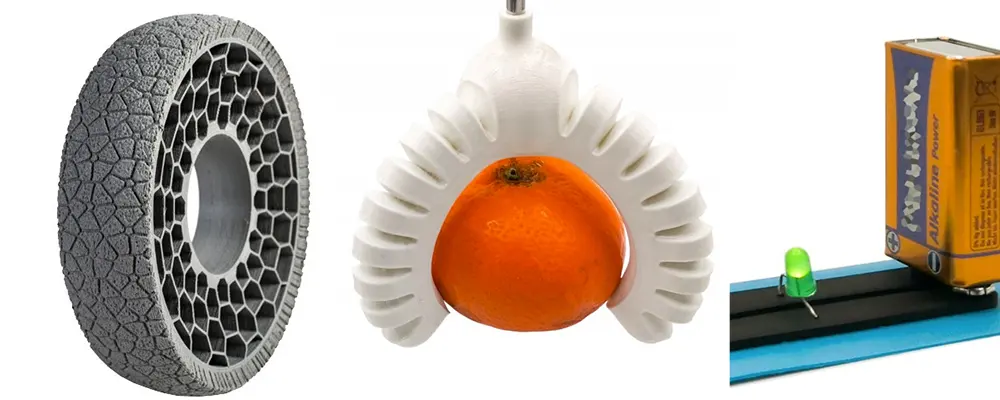
Filaflex was first created in 2013 as one of the first elastic filaments for 3D printers, and since that time the company has introduced several versions, including a TPU 100% from recycled origin and a new electrically conductive TPU called Conductive Filaflex.
The filaments of the Filaflex range have great print bed adhesion, so they don’t need a heated bed, blue tape, or any adhesive. They’re also odorless and resistant to solvents, acetone, and fuel.
Reciflex is a flexible TPU filament, 100% of recycled origin, both from footwear industry leftovers and from Recreus’ internal production. Its hardness ranges between 96A and 98A Shore due to the variations attributable to its origin as a recycled material, practically imperceptible in the printed parts.
| Printing Temp. | Density | Bed Temp. | Speed | |
| Filaflex | 215-225 °C | 1.07 g/cm3 | 21 °C | 20-30 mm/s |
| Filaflex | 215-235 °C | 1.08 g/cm3 | >40 °C | 20-40 mm/s |
| Filaflex | 215-250 °C | 1.12 g/cm3 | – | 20-60 mm/s |
| Filaflex | 215-230 °C | 1 g/cm3 | >40 °C | 20-70 mm/s |
| Reciflex | 220-235 °C | 1 – 1.22 g/cm3 | 50 – 60 °C | 40 mm/s |
Colors: 10+ depending on product
Polymaker
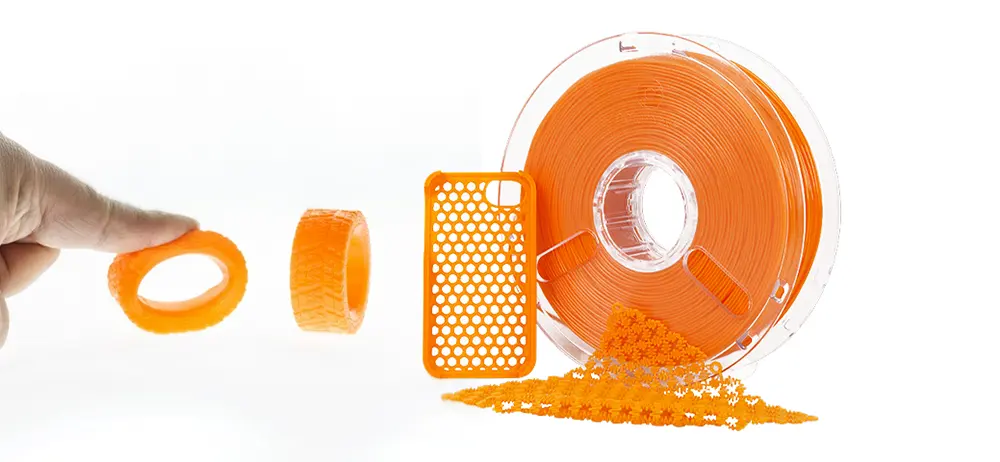
Polymaker has three TPUs in its PolyFlex line, which are all based on chemistry from industrial polymer maker Covestro.
PolyFlex TPU90 is designed to provide great flexibility without compromising on printing speed. It also has the ability to resist damage from ultra-violet (UV) light. PolyFlex TPU95 is engineered to work on most desktop 3D printers, the company says, while PolyFlex TPU95-HF is ideal for high-speed printing.
| Printing Temp. | Density | Bed Temp. | Speed | |
| PolyFlex TPU90 | 210-230˚C | na | 50-60 °C | 30-60 mm/s |
| PolyFlex TPU95 | 210-230˚C | na | 25-60 °C | 20-40 mm/s |
| PolyFlex TPU95-HF | 200-220˚C | na | 25-50 °C | 40-100 mm/s |
Available sizes & diameters: 750 g; 1.75 mm, 2.85 mmv
Colors: Black, white, red, blue, yellow, orange
Forward AM / BASF
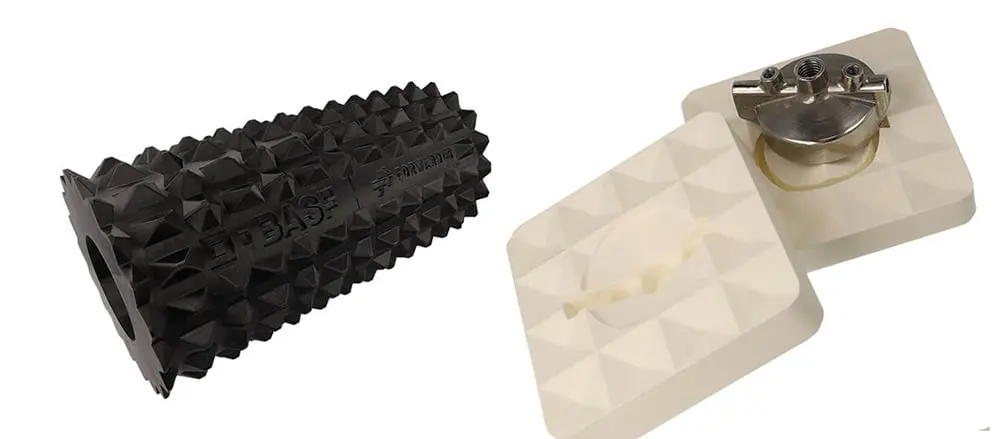
Forward AM, the additive manufacturing arm of chemical giant BASF, offers its Ultrafuse line is several flexible variations. The Ultrafuse TPU 85A is based on BASF’s Elastollan chemical materials and the company says it features maximum reliability, consistent product quality, and cost-efficiency.
The company’s TPC 45D is a rubber-like filament derived from rapeseed oil and is proven to have a carbon footprint up to 50% lower than comparable co-polyesters, according to BASF. The TPS 90A is a very versatile material featuring a rubber-like soft touch and non-slip properties. Especially useful, the material shows a reduced moisture uptake, which allows for printing without pre-drying.
| Printing Temp. | Density | Bed Temp. | Speed | |
| TPU 85A | 200-220 °C | – | 40 °C | 15-40 mm/s |
| TPC 45D | 220-240 °C | – | 20 °C | 20-50 mm/s |
| TPU 64D | 230-255 °C | – | 40 – 60 °C | 30-60 mm/s |
| TPU 95A | 210-230 °C | – | 40 °C | 14-40 mm/s |
| TPS 90A | 260-280 °C | – | 70 – 90 °C | 10-30 mm/s |
Available sizes & diameters: 1 kg; 1.75 mm, 2.85 mm
Colors: black, white, clear, red, orange
ColorFabb
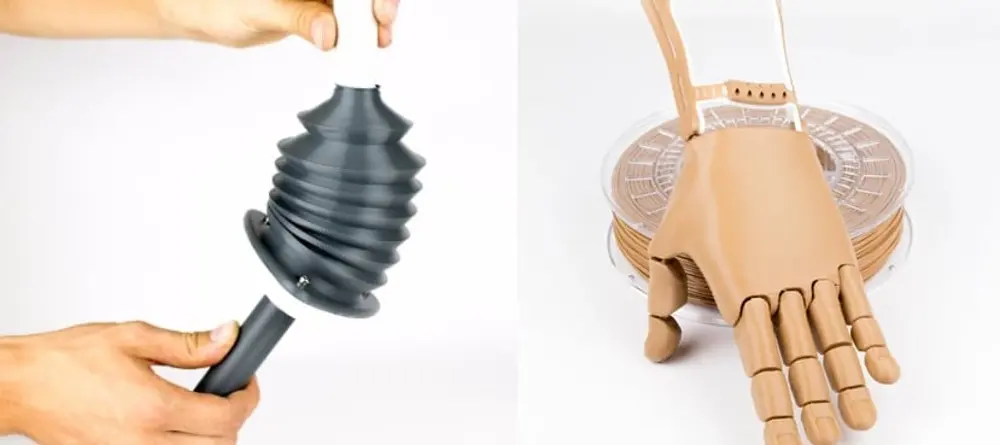
ColorFabb’s nGen Flex, made with Eastman’s Amphora FL6000, is a flexible material uniquely engineered for industrial extrusion-based additive manufacturing processes. The company says its layer-to-layer adhesion and melt strength enables it to prints at a faster speed than other elastomeric materials, saving you time. The nGen Flex is an engineering-grade material with high durability and toughness, enabling designers to create truly functional parts that can withstand the rigors of everyday use.
nGen Flex’s high-temperature resistance enables steam sterilization so users may find it to be the ideal polymer for additive manufacturing of prosthetics and orthotics, along with automotive parts, apparel, tooling, or a variety of consumer products.
The ColorFabb varioShore TPU features variable shore hardness, reduced weight and density, and soft touch. The variable softness is achieved by altering the print temperature. Temperatures between 200ºC and 250ºC will result in very soft prints whereas lower temperatures result in more rigid prints.
| Printing Temp. | Density | Bed Temp | Speed | |
| nGen Flex | 240-260 ºC | 1.13 g/cm3 | 80 ºC | 40-60 mm/s |
| varioShore TPU | 190-250 ºC | 1.22 g/cm3 | 20-40 ºC | 20-30 mm/s |
Available sizes & diameters: 0.65 kg, 2 kg; 1.75 mm, 2.85 mm
Colors: clear, black, dark grey
Kimya
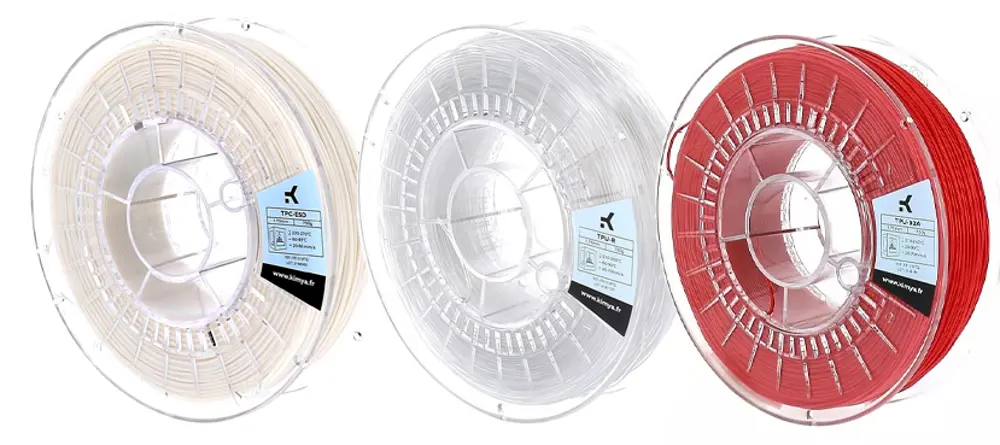
Kimya makes three different types of flexible filament: PEBA, TPU, TPC, and even a rTPU from 100% recycled materials.
The company’s PEBA is based on the PEBAX material by Arkema. It can be used to make shoe soles or other sports equipment and offers substantial energy returns. The Kimya TPC-91A 3D filament offers chemical and impact resistance and is used in industrial applications in sectors, such as electronics, textiles, and roofing, along with decorative and leisure 3D printing applications.
The Kimya TPU-92A 3D filament offers good resistance to heat and to the external environment and it’s food-safe.
| Printing Temp. | Density | Bed Temp. | Speed | |
| PEBA-S | 210-260 °C | 1.01 g/cm3 | 70-90 °C | 20-60 mm/s |
| TPC-91A | 230-270 °C | 1.22 g/cm3 | 60-85 °C | 20-60 mm/s |
| TPC-ESD | 230-270 °C | 1.2 g/cm3 | 60-85 °C | 20-60 mm/s |
| TPU-92A | 210-250 °C | 1.16 g/cm3 | 60-90 °C | 20-70 mm/s |
| TPU-R | 210-250 °C | 1.14 g/cm3 | 60-90 °C | 20-70 mm/s |
Available sizes & diameters: .75 kg; 1.75 mm, 2.85 mm
Colors: black, translucent, red, white, dark blue
Formfutura
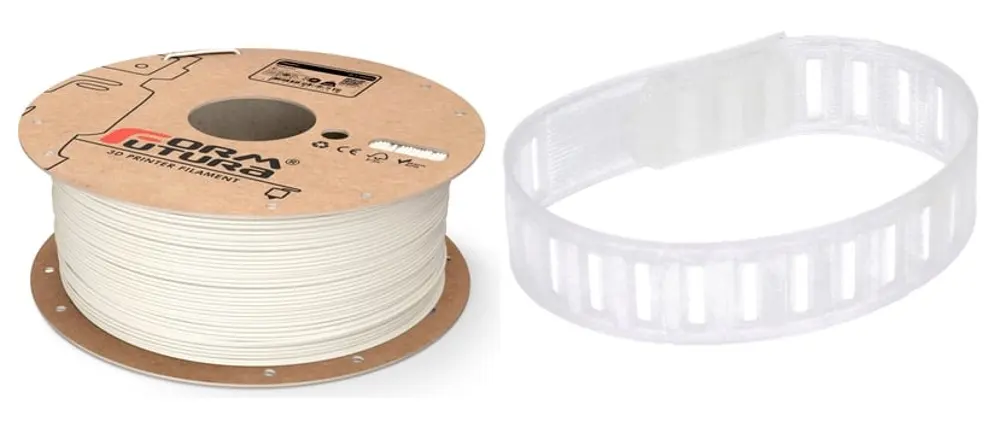
Formfutura’s FlexiFil is a rubber-like high-performance TPC (thermoplastic co-polyester) with a type of “flexural memory” that enables objects to return back to their original position after being bent. Formfuture says FlexiFil is unique in its combination of flexibility, mechanical strength, durability, good resistance to chemicals, excellent UV resistance and ability to withstand extreme temperatures.
Formfutura’s Python Flex is a TPU filament for flexible and elastic parts that are designed for high-speed printing on both direct drive and Bowden style extruders, the company says. Python Flex can be printed directly on a glass plate without having to use a heated bed. The filament is extremely transparent in its natural form.
Formfutura says its MD Flex is a flexible TPU type of 3D printer filament enhanced with a patented nano-copper composite that eliminates more than 99.99% of fungi, viruses, bacteria and microorganisms, and has been scientifically proven effective against SARS-CoV-2 / Covid-19 with high antiviral efficacy.
| Printing Temp. | Density | Bed Temp. | Speed | |
| FlexiFil | 220-260 ºC | 1.14 g/cm3 | 90-110 ºC | – |
| Python Flex | 220-250 ºC | 1.16 g/cm3 | >60 ºC | 50-100 mm/s |
| MD Flex | 220-250 ºC | 1.16 g/cm3 | >60 ºC | – |
Available sizes & diameters: 0.65 kg, 2 kg; 1.75 mm, 2.85 mm
Colors: clear, black, dark grey
MatterHackers
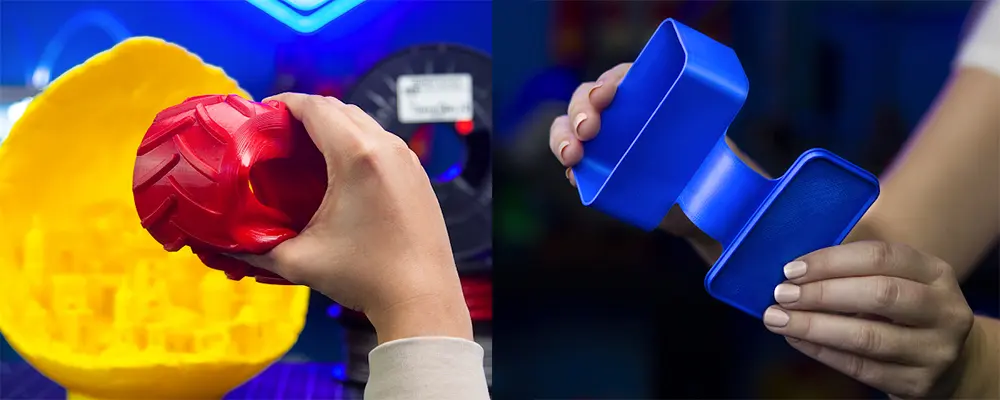
MatterHackers Pro Series TPU is definitely on the more flexible side of the spectrum. If you want something even bendier, they also sell a Pro Series Flex TPE that’s similarly impressive.
The Pro Series TPU is a highly malleable elastomer that is used to create prints with high toughness while retaining superb flexibility. It also has a high resistance to abrasion. This TPU will adhere to most bed types without any adhesives and a cooling fan is highly recommended.
| Printing Temp. | Density | Bed Temp. | Speed | |
| Pro Series TPU | 230 ±10 ºC | ~1.1 g/cm3 | – | 20-40 mm/s |
| PRO Series Flex TPE | 235 ºC | ~1.1 g/cm3 | 50-65 ºC | 15 mm/s |
- Available sizes & diameters: 1 lb (~450 g); 1.75 mm, 2.85 mm
- Colors: Black, white, red, blue, clear, grey, green
3D Jake
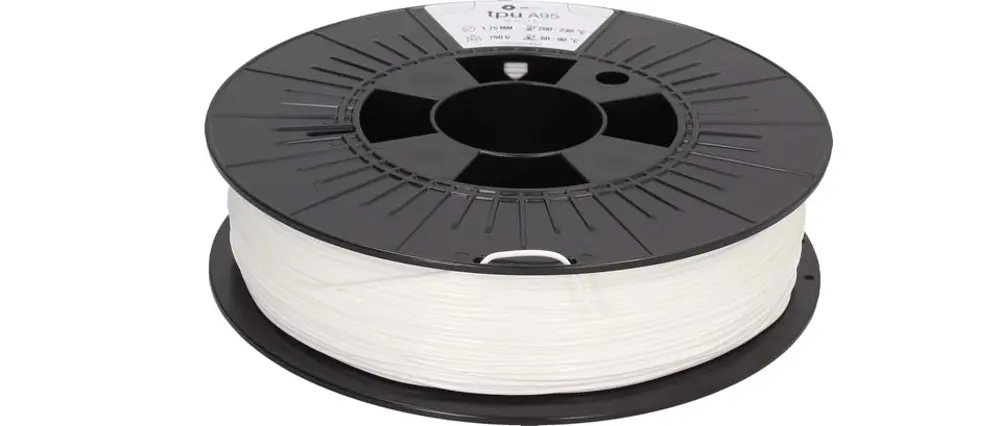
European 3D printer and materials reseller 3D Jake ventured into manufacturing its own branded filament years ago and it has gained a following for quality.
The 3D Jake TPU has a low tendency to warp so it can also be printed without a heated bed, but if you have a heated bed the recommended temperature is 60-90˚C. TPU A95 can be used on all common desktop FDM 3D printers. 3D Jake recommends increasing the flow by about 5-10% for more consistent extrusion.
| Printing Temp. | Density | Bed Temp. | Speed | |
| TPU A95 | ~220 ºC | na | 25-50 ºC | >100 mm/s |
Available sizes & diameters: 1 kg; 1.75 mm, 2.85 mm
Colors: white, blue, red, orange, clear
Dynamism TPU95
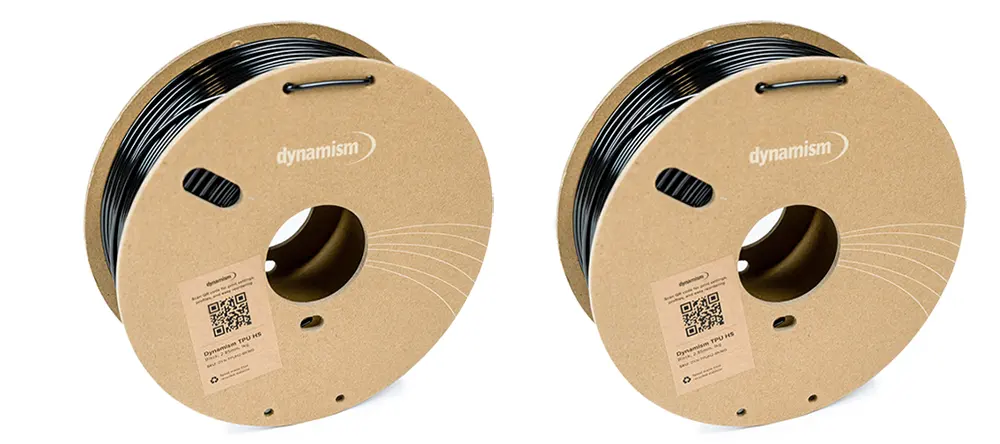
Dynamism is another 3D printer and materials supplier that has branded its own TPU filament to sell to customers as the most economical of its TPU offerings. But this is no discount filament. Dynamism TPU HS is a workhorse, general-purpose flexible filament formulated for high flow to allow for printing at higher extrusion speeds. As a sustainability bonus, it comes on recycled cardboard spools and with external cardboard packaging also made from recycled cardboard.
| Printing Temp. | Density | Bed Temp. | Speed | |
| TPU95 | ~220 ºC | na | 25-50 ºC | >100 mm/s |
Available sizes & diameters: 1 kg; 1.75 mm, 2.85 mm
Colors: black
Flexible Filament From Your Printer Manufacturer
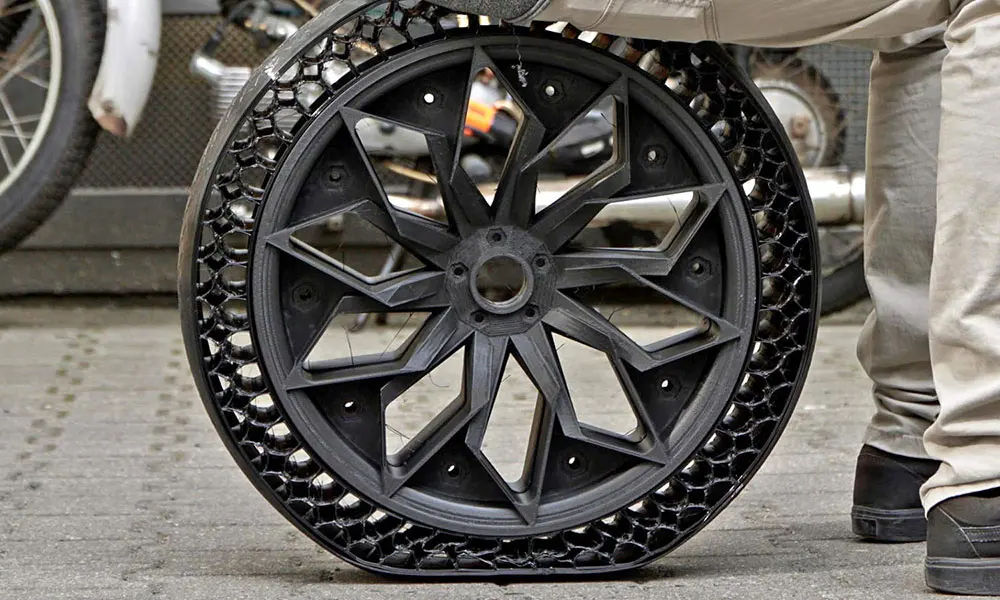
Because of the difficulty of printing some flexible filaments and, unfortunately, some of the poor quality filaments on the market, several printer manufacturers, including Ultimaker, Big Rep, BCN3D, and others, have worked with chemical makers to formulate their own flexible filaments tuned to specifically to their printers. These filaments can save a lot of time and fine-tuning, which can easily justify the usually higher price tag.
If your printer brand offers its own flexible filament its likely to come with well-tested print profiles and is probably your best bet, or at least your best first step when it comes to successful printing of flexible parts.
| Brand | Material | Shore | Elongation at Break | Price | Where to Buy |
| Ultimaker | NFC TPU | 95A | 580% | $70 / .75 kg | |
| Big Rep | TPU | 98A | 470 % | $115 / 2 kg | |
| BCN3D | TPU 95A | 98A | 450% | $75 / .75 kg | |
| Stratasys | TPU 92A Elastomer | 92A | 552% | na | |
| Zortrax | Z-Flex | 31D | 3319% | $76 / .8 kg | |
| Raise3D | Premium TPU-95A | 95A | 330% | $94 / 1 kg |
Which Filament Types are Flexible?
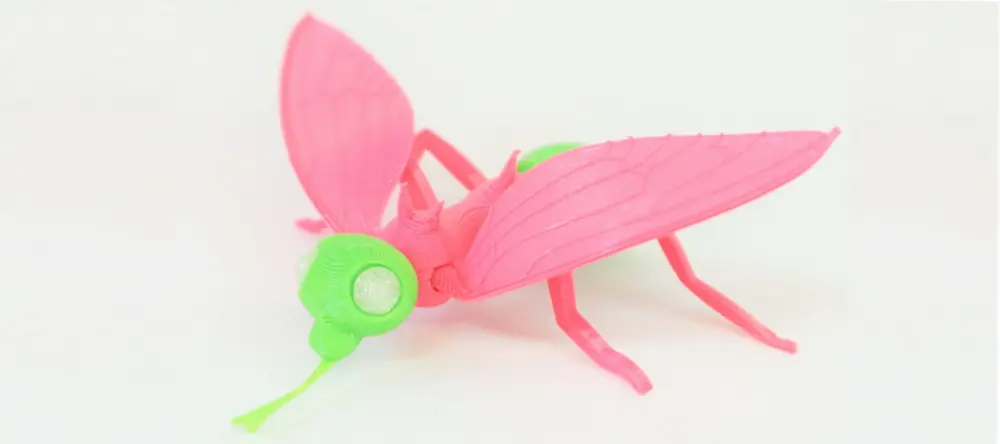
If you need your final parts to have a degree of flexibility – anything from super rubbery to just a touch of give – you’ll want to pay attention to a few key measurements that are detailed in your filaments’ technical datasheet. Some filament called “flexible” may not disclose exactly what it’s made of, so to know how parts made from it will perform, you’ll need to understand the following terms.
Shore Hardness
Shore hardness is a common term you’ll hear when it comes to polymers, but it’s more general than the more technical measurements like Young’s modulus or elongation at break. For example, most flexible filament would be Shore A, and within the A category they would have individual values, such as Shore hardness 95A. You may also see Shore values in the C or D category, which more often denote hard rubbers and semi-rigid plastics. The most common Shore value for flexible filaments is 95A.
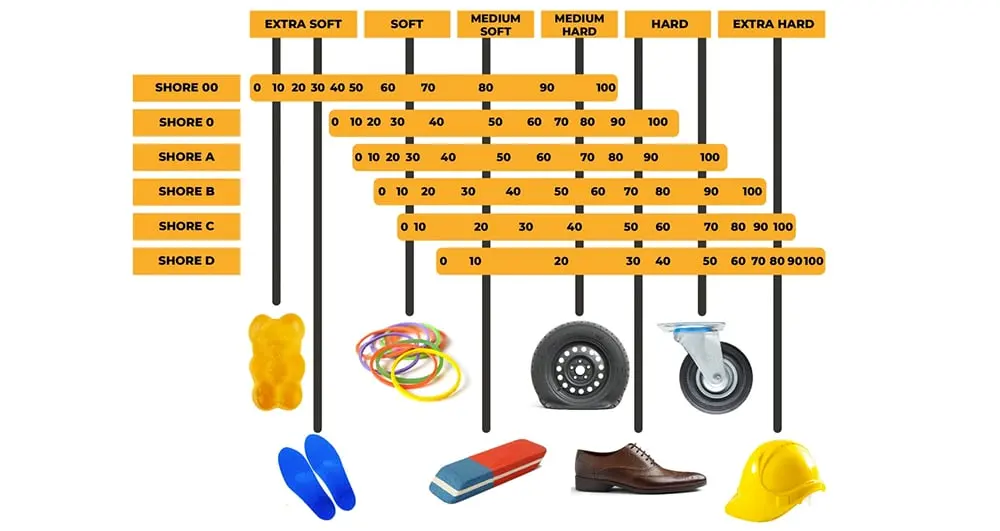
Elongation at Break
Elongation at break is how much a part can stretch before breaking. This measurement is shown as a percentage and the higher the number the better the material will resist reforming when stretched. Flexible filaments average around 600% elongation at break. By comparison, regular PLA averages around 8%.
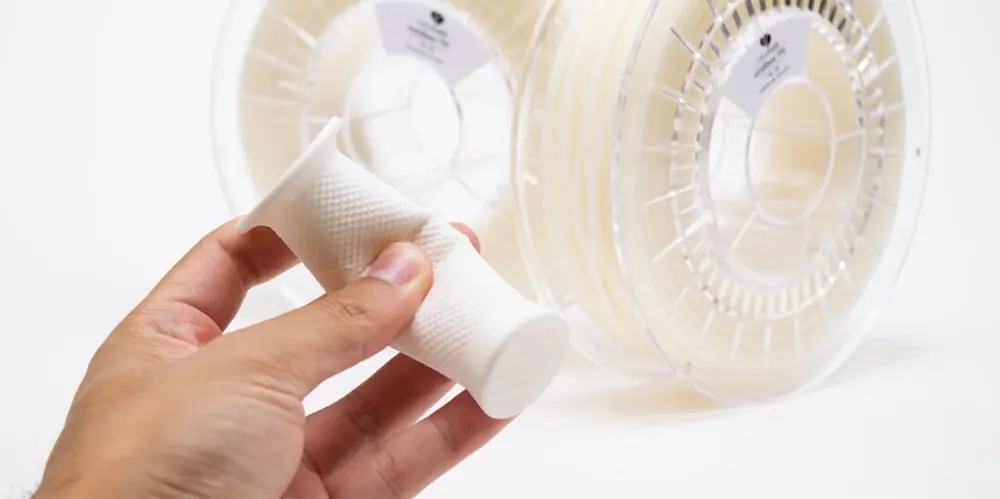
Know Your Flexible Plastic Types
There’s more to flexible filaments than thermoplastic elastomers, but do you really need to know polymer chemistry? Probably not. Yet, here are few notable distinctions between the major flexible polymers that could be useful understand.
TPE (thermoplastic elastomers)
TPEs are a class of materials that are a blend of plastic and rubber. TPU, is in this class along with TPC, but there are others. These plastics are very soft and rubber-like. They are common in injection molding and parts made from them can be bent or stretched without any deformation.
- TPU (thermoplastic polyurethane) is a subset of TPE that have become more popular in 3D printing because their hardness can be highly customized. TPUs can be as soft as rubber or as hard as rigid plastics, which makes for easier extruding. TPUs are also generally more durable and can offer higher resistance to abrasion, oils, chemicals, and high and low temperatures than TPE filament.
- TPC (thermoplastic co-polyester) is another common type of TPE that boasts high-temperature resistance, high strength, and excellent UV resistance. It is especially prized in biomedical applications and for wearable and medical devices. More commonly used in powder bed fusion 3D printing, these polymers have a bending memory and make for very durable yet rubber-like parts.
- TPS (styrene-based thermoplastic elastomer) is characterized by its soft touch. Compared to other flexible materials, it shows better non-slip properties, ideal for grippers. TPSs don’t absorb as much moisture as other TPEs, which enables printing without pre-drying.
- PEBA (polyether block amide) is a TPE that can stay flexible under very cold conditions. It features a very low density, which gives it excellent dampening properties, energy return, and flexibility. It’s used widely in sports equipment and also in for electric components.
Tips for Printing with Flexible Filament
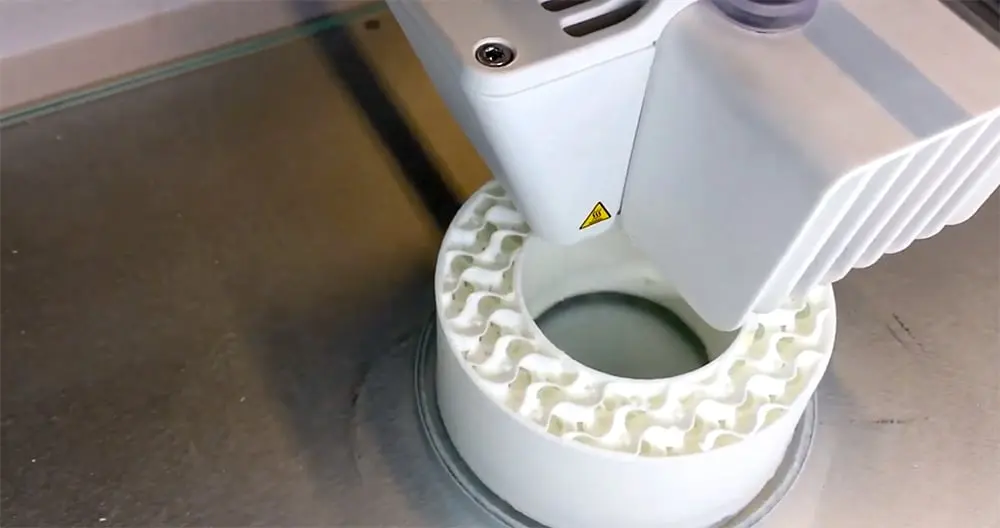
You can throw out everything you’ve heard about printing with flexible filament. Today, there is such a wide range of flexible filament types that it’s almost impossible to give general direction, but there are certainly some important points to keep in mind.
Dry Before You Print
Flexible filament is often, but not always, very hygroscopic, meaning that it sucks up moisture from the air. If you open your sealed filament and expose to air, it will have a negative effect on the printing behavior and, of course, the quality of your final print. Even if you follow the printer settings exactly, you can still end up with failed or suboptimal prints because of moist filament.
If your filament’s been left out, you’ll need to dry it in an oven or a filament dryer. How long and what temperature? Well, that can be the tricky part because there’s often no way to know how much moisture the filament has soaked up. Your drying machine may let you know when the filament is dry, and the filament manufacturer may include drying instructions with the filament (such as dry in an oven at 70 ºC for five hours), but in the end, it’s often trial and error. Just remember: if you see steam rising from your hot end, your filament is wet.
Your best bet is to try to keep your filament sealed and stored properly in the first place (also protected from UV light and heat) and for as long as possible. If this isn’t possible, look for flexible filaments that don’t require any drying, including some made of TPS.
Heat & Prep Your Bed
Many flexible filament manufacturers say their products don’t require a heated bed, but most filaments do perform and adhere better with a bed temp around, 40ºC but usually not more than 60ºC. Your filament will come with recommended bed temperatures. Flexible filaments almost never require a closed chamber, but again, keeping your heat consistent is always a help. Whether or not you need tape, glue, or adhesives on your bed depends on your filament type and brand.
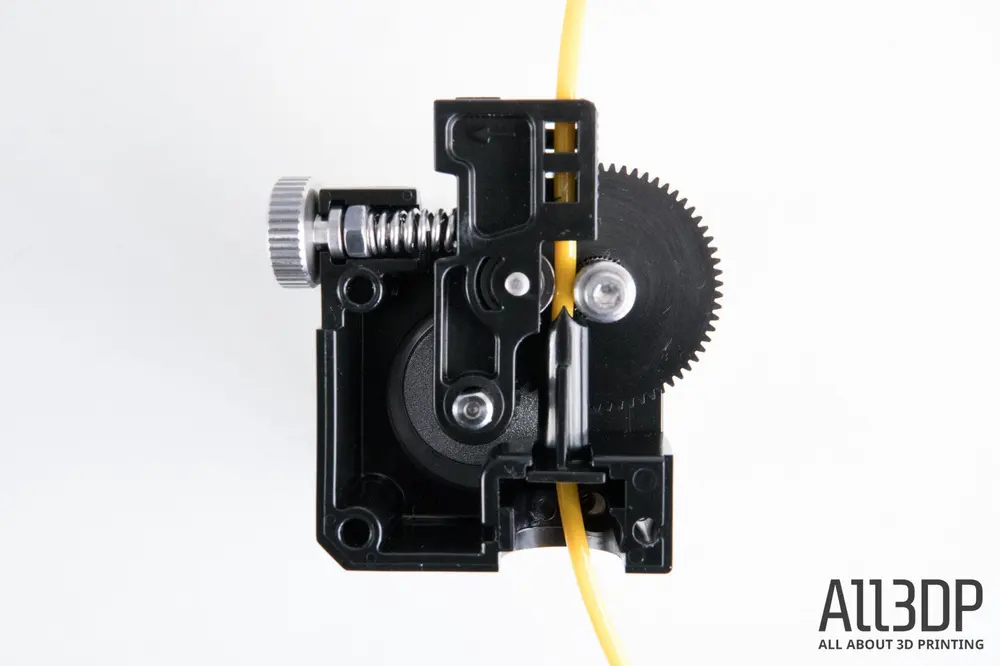
Nozzle Temp
Your filament comes with recommended printing temperatures for a reason. Yes, a hotter nozzle can make for faster printing, but printing temperature can affect the flexibility of your final print. Ideally, your 3D printer will have a print profile for the exact brand of flexible filament you’re using, otherwise, prepare to experiment and achieve the ideal balance between heat and speed.
Be Patient, Go Slow
To get those almost-invisible layer lines and a consistent soft-to-the-touch finish, your flexible filament will need time. Thermoplastic elastomers like to go slow and typically print best at slower speeds and smaller layer heights. Filament makers have made great strides in fast-printing flexible materials with some churning out parts at 100 mm/s, but there’s always some sacrifice of print quality with speed.
If your flexible filament clogs your extruder, high-speed is the likely culprit, although it could also be moisture in your filament.
Extruder & Extruder Settings
Many flexible filaments work fine with Bowden extruders but most will work best with a Direct Drive extruder. The reason is that the distance between the drive gear and the hot end should be as short as possible to efficiently feed the filament into the nozzle without stretching it.
As with any material, follow your print profiles, but if you don’t have any or want to experiment, there are some things to keep in mind when it comes to your extruder retraction rate. You may come across advice that says to disable retractions when printing with flexible filament, but that’s a bit outdated. It may apply if you have an older extruder, but newer extruders and professional FDM printers shouldn’t have any issues with retraction. With retractions off, you’ll see some stringing that can be removed in post-processing.
Even in the best FDM printers, you may still need to experiment with your retraction settings. Keeping them to 2 mm and 20 mm/s is a good place to start. If you notice the filament bunching up in the extruder, keep adjusting your retraction settings until you find the sweet spot.
Additional Tips:
- Avoid using rafts because the base layers have a higher extrusion rate, which could lead to problems.
- Where possible, mount the filament spool above the printer to reduce resistance from the extruder pulling the filament
- Part cooling ran is required
Get Your TPU Parts Printed
If TPU doesn’t sound like a material you’re ready to master, you can leave it to the pros at FacFox.
Source: The Best TPU / Flexible Filaments of 2022 | All3DP Pro